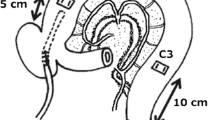Summary
-
1)
Substance P (SP), somatostatin (Som), and vasoactive intestinal polypeptide (VIP) induced a concentration-dependent release of histamine from isolated rat peritoneal mast cells.
-
2)
The release of histamine induced by these neuropeptides was inhibited by preincubation of the cells with the SP analogue [d-Pro4,d-Trp7,9,10]-SP4–11 (SP-A) (10 μM), and also by benzalkonium chloride (10 μM). In addition, SP-A inhibited histamine release induced by compound 48/80, whilst that induced by goat anti-(rat-IgE) was unaffected.
-
3)
In human skin, intradermal injection of SP, Som, or VIP produced flare and wheal responses. The flares to all three peptides were inhibited by preinjection of the skin with SP-A (25 pmol), whilst the wheal responses were unaffected.
-
4)
It is concluded that the receptors mediating histamine release and the flare response are similar, and that SP, Som, and VIP are acting at a similar receptor to produce these effects. It is probable that this receptor is also the site of action of compound 48/80.
Similar content being viewed by others
References
Anand P, Bloom SR, McGregor GP (1983) Topical capsaicin pretreatment inhibits axon reflex vasodilatation caused by somatostatin and vasoactive intestinal polypeptide in human skin. Br J Pharmacol 78:665–669
Bailey SJ, Featherstone RL, Jordan CC, Morton IKM (1983) An examination of [d-Pro4,d-Trp7,9,10]SP4–11 as a tachykinin antagonist. In: Skrabanek P, Powell D (eds) Substance P —Dublin 1983. Boole Press, Dublin, pp 16–17
Erjavec F, Lembeck F, Florjanc-Irman T, Skofitsch G, Donnerer J, Saria A, Holzer P (1981) Release of histamine by substance P. Naunyn-Schmiedeberg's Arch Pharmacol 317:67–70
Fewtrell CMS, Foreman JC, Jordan CC, Oehme P, Renner H, Stewart JM (1982) The effects of substance P on histamine and 5-hydroxytryptamine release in the rat. J Physiol 330:393–411
Foreman JC, Hallet MB, Mongar JL (1977) The relationship between histamine secretion and 45calcium uptake in mast cells. J Physiol 271:193–214
Foreman JC, Jordan CC, Piotrowski W (1982) Interaction of neurotensin with the substance P receptor mediating histamine release from rat mast cells and the flare in human skin. Br J Pharmacol 77:531–539
Foreman JC, Jordan CC, Oehme P, Renner H (1983) Structure-activity relationships for some substance P-related peptides that cause wheal and flare reactions in human skin. J Physiol 335:449–465
Hökfelt T, Lundberg JM, Schultzberg M, Johansson O, Skirboll L, Angaard A, Fredholm B, Hamberger B, Pernow B, Rehfeld J, Goldstein M (1980) Cellular localisation of peptides in neural structures. Proc Roy Soc Lond B 210:63–77
Jasani B, Kreil G, Mackler B, Stanworth DR (1979) Further studies on the structural requirements for polypeptide mediated histamine release from rat mast cells. Biochem J 181:623–632
Johnson AR, Erdös EG (1973) Release of histamine from mast cells by vasoactive peptides. Proc Soc Exp Biol Med 142:1252–1256
Kitada C, Ashida Y, Maki Y, Fujimo M, Hirai T, Yasuhara T, Nakajima T, Takeyama M, Kojama K, Yajima H (1980) Synthesis of granuloliberin-R and various fragment peptides and their histamine releasing activities. Chem Pharm Bull 28:887–892
Lembeck F, Gamse R (1982) substance P in peripheral sensory processes. In: Porter R, O'Connor M (eds) Substance P in the nervous system, CIBA foundation symposium: 91. Pitman, London, pp 35–54
Manavalan P, Momanay FA (1982) Conformational energy calculations on substance P. Int J Protein Peptide Res 20: 351–365
Moody TW, Thoa NB, O'Donohue TL, Jacobowitz DM (1981) Bombesin-like peptides in rat spinal cord: biochemical characterisation, localisation and mechanism of release. Life Sci 29:2273–2279
O'Shaughessy DJ, McGregor GP, Ghatei MA, Blank MA, Springall DR, Gu J, Polak JM, Bloom SR (1983) Distribution of bombesin, somatostatin, substance P, and vasoactive intestinal polypeptide in feline and porcine skin. Life Sci 32:2827–2836
Paton WDM (1957) Histamine release by compounds of simple chemical structure. Pharmacol Rev 9:269–328
Piotrowski W, Devoy MAB, Jordan CC, Foreman JC (1984) The substance P receptor on rat mast cells and in human skin. Agents Actions 14:420–424
Piotrowski W, Jordan CC, Foreman JC (1983) The effect of [d-Pro4,d-Trp7,9,10]-SP4–11 on histamine release and human skin responses induced by substance P. In: Skrabanek P, Powell D (eds) Substance P — Dublin 1983. Boole Press, Dublin, pp 96–97
Read GW, Kiefer EF (1979) Benzalkonium chloride: selective inhibitor of histamine release induced by compound 48/80 and other polyamines. J Pharmacol Exp Ther 211:711–715
Regoli D, Escher E, Drapeau G, D'Orleans-Juste P, Mizrahi J (1984a) Receptors for substance P. III. Classification by competitive antagonists. Eur J Pharmacol 97:179–189
Regoli D, Mizrahi J, D'Orleans-Juste P, Escher E (1984b) Receptors for substance P. II. Classification by agonist fragments and homologues. Eur J Pharmacol 97:171–177
Rothschild AM (1966) Histamine release by basic compounds. In: Rocha e Silva (ed) Histamine and antihistamines. Springer, Berlin Heidelberg New York, pp 386–430
Shanahan F, Befus AD, Fox J, Denburg JA, Bienstock J (1983) Mast cell subpopulations and their response to substance P. In: Skrabanek P, Powell D (eds) Substance P — Dublin 1983. Boole Press, Dublin, pp 145–146
Shore PA, Burkhalter A, Cohn VH (1959) A method for the fluorimetric assay of histamine in tissue. J Pharmacol Exp Ther 127:182–186
Skofitsch G, Donnerer J, Petronjevic S, Saria A, Lembeck F (1983) Release of histamine by neuropeptides from the perfused rat hindquarter. Naunyn-Schmiedeberg's Arch Pharmacol 322: 153–157
Theoharides TC, Douglas WW (1981) Mast cell histamine secretion in response to somatostatin analogues: structural considerations. Eur J Pharmacol 73:131–136
Theoharides TC, Betchaku T, Douglas WW (1981) Somatostatin-induced histamine secretion in mast cells. Characterisation of the effect. Eur J Pharmacol 69:127–137
Author information
Authors and Affiliations
Rights and permissions
About this article
Cite this article
Piotrowski, W., Foreman, J.C. On the actions of substance P, somatostatin, and vasoactive intestinal polypeptide on rat peritoneal mast cells and in human skin. Naunyn-Schmiedeberg's Arch. Pharmacol. 331, 364–368 (1985). https://doi.org/10.1007/BF00500821
Received:
Accepted:
Issue Date:
DOI: https://doi.org/10.1007/BF00500821




